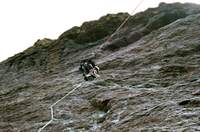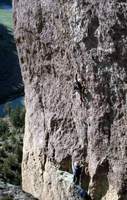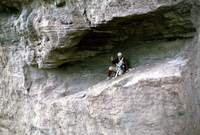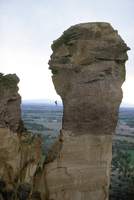Monkey Face

Dave and I discovered Smith Rock while on a ski vacation in Oregon as we
were driving from one ski area to another.
I noticed the rock formations jutting out of the flat plain,
obviously a misplaced piece of geology that bore further investigation.
It was evening so we decided to camp at the park and do some hiking the
next day as a break from skiing.
The rock formations were so inviting we vowed to return with our rock
climbing gear in the near future.
This picture taken from near the river that runs through the park illustrates
why one of the prominent features of the park is called
“Monkey Face.”
A portion of Pioneer Route up the formation is shown in red.
This is the easiest route,
but is quite exhilarating because the lead from the belay point marked
“B”
to the mouth is mostly a slight overhang,
with 400 feet of exposure to the sagebrush below.

This picture is taken from the opposite side and shows the other part of
the Pioneer Route in red.
The climb up to the notch between the ridge
(left)
and the pinnacle is relatively easy class 5.
After the overhanging pitch shown in the previous picture,
one exits the opposite corner of the mouth for a very exposed short
class 5 climb followed by easy class 4 to the summit.

I led the aid pitch up to the mouth.
The red rope is hanging straight down,
illustrating the overhang above the belay point as one approaches the mouth.
The reach to the last bolt to gain access to the mouth was too far for
me.
This meant I could not complete the climb AND I had to climb down to
retrieve the slings and carabiners.
I left one sling and carabiner at the top so I had an upper belay for
the down-climb.
As I descended,
the upper belay was pulling me out from the face due to the overhang;
as I removed the lowest point of protection I lost my grip and went
swinging back over the abyss–
it felt like
this.
My belayer had the presence of mind to lower me just enough on the
return swing so I landed on the belay ledge next to him where I was able
to grab the anchor and avoid a repeat swing.

One of the interesting features of Monkey Face is the fact the tower is
really a detached pinnacle at the end of a ridge.
Thus,
it is possible to hike up the ridge and get close to the pinnacle to
watch others climb.
A large boulder sits on a ledge above the mouth.
Getting from the mouth up to the slings climbers have left on the boulder
is the most interesting part of the free climbing.
Above that the climbing is easy.
For the return,
one climbs down to where the slings are and rappels.

From the ridge vantage point we were able to watch Dave lead the overhang,
with Rebecca at the belay ledge.

Dave made it to the Monkey's mouth.
It turned out that Rebecca could not follow Dave up the overhang,
so he also had to rappel from the mouth and retreat from the climb.
Dave had more experience with aid climbing and showed me a technique to
both extend my reach and use less strength.
Dave and I returned the next day and I led the pitch into the mouth.
The day was windy and cold,
and there was no sun in the mouth to keep me warm.
Furthermore,
the mouth seemed to concentrate the wind.
As Dave followed up to the mouth I got colder and colder.
When he arrived at the mouth he offered to let me lead out of the mouth
into the sun but I was so cold and shivering I felt I was in no condition
to lead so he
“leap-frogged”
(which is the usual case in technical climbing)
and lead to the summit.
With an upper belay I was then confident enough to continue in spite of
my shivering.
On the sunny summit I was soon warm again.

The rappel from the top is quite exposed.
We used two 50 meter
(164 foot)
ropes to reach a safe stance below.
Note the flat farmland surrounding the park.






